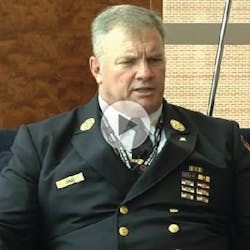FDNY Deputy Chief Recalls Collapse of Tower, Survival
He and his crew from Ladder 6 survived the collapse of the North Tower of the World Trade Center on 9/11 and lived to talk about it.
"All my men made it and I sent them home to their families that night. It's certainly not a common thing that happened that day," he said in an interview with Firehouse.com.
Over the past 10 years, Jonas said the FDNY underwent massive change from turnover in personnel to enhancements in training and technology.
That day, he held the rank of captain. Five days later he was promoted to deputy chief.
"We had to deal with the immediate issues of grief and bereavement of losing some of the most qualified people and terrific human beings the fire department has ever had. That was difficult to overcome," he said.
"The fire department got very young overnight. Those of us who stayed helped train all of these younger firefighters coming on to take the place of those killed or retired.
"The younger guys saw the legacy they were adopting and they met it."
In the days, weeks and months following the terrorist attacks, he said there was close examination of what went on that day and what could have been improved.
"You can't lose 343 people and say 'We're good,' " he said. "Next time -- God forbid if this happens again -- maybe we won't get hit as hard."
The department adopted almost all of the recommendations suggested by an outside firm looking at ways to improve response to similar incidents and has launched several initiatives that will improve the department in the future.
"Even while were still recovering emotionally from the events of that day, (the department) was moving forward. They said, 'We have to get better, we have to improve our safety, we have to improve our communications.' And they've done that."
The Tragic Day
At approximately 8:46 a.m., Ladder 6 was preparing to change shifts when they heard the sound of a plane flying above them.
"We could hear it hit the North Tower," Jonas said.
The crew made its way to the World Trade Center and entered the tower to receive orders.
"As we were responding in, we could see large gaping holes in two sides of the North Tower and there was smoke and fire coming out under pressure and it was an incredible site," he said.
"I had 22 years on the fire department at the time in some very busy places and nothing prepared me for what I was seeing."
Deputy Chief Pete Haden was about to give them orders when they saw a large black shadow on the ground and we heard a loud explosion.
"We didn't know what it was. A man came running in from the outside and said 'A second plane has just hit the second tower,' ". He said. "Now we knew we were under attack. It was not an accident."
Jonas said that one of the most poignant things that was said to him that day was by a firefighter he was standing near at that moment.
"Gentleman, we may not live through today," he told the men.
All of them wished each other good luck and shook each other's hands."
"Out of all of the guys I was surrounded by when the plane hit the South Tower, I'm the only one that's alive. They all died," Jonas said.
The Climb
After receiving orders to do a search and rescue of the North Tower, they went up by foot, making it to the 27th floor.
They stopped to catch their breath and get a quick drink of water when they felt and heard the collapse of the South Tower.
"That was indication to me that our mission was no longer workable, that it was time for us to get out of there," Jonas said.
As they headed down the stairs, they encountered a 59-year-old woman named Josephine Harris on the 20th floor. She had a limp and was unable to make it down on her own.
Firefighter Tommy Falko turned to Jonas and said: "Cap, what do you want to do with her?"
At that point he said they were "essentially running for their lives," but they just couldn't pass her.
"We decided to put ourselves in harm's way to save her."
They started to carry her downstairs, but were blocking people from behind them trying to get out so they had to step aside and let them through.
When they made it to the fourth floor, Harris fell to the floor and told the firefighters to leave her.
"We weren't going to leave her," Jonas said.
He broke into the floor to try to find a chair they could bring her down on, but couldn't find one.
The Collapse
As he made his way back to Stairwell B, the collapse of the North Tower had begun.
"We kept waiting for the big beam or the big piece of concrete to come and get us and for us it didn't come."
Once the collapse stopped, a role call was given and everyone was accounted for.
There were a total of 13 people in the stairwell and all of them were somehow unscathed, but now they were trapped.
"We went through the ordeal of trying to figure out how to get out. Once we realized we couldn't help ourselves, we came to the realization that we needed to be rescued."
He began talking on the radio to some of his closest friend on the fire department; something he said was very comforting.
Four hours passed and suddenly they spotted a ray of sunshine that hit the stairway. The dust had settled and the air had cleared, allowing the light to come through.
They realized at that point that while they were only on the fourth floor, they were on what became the top floor of the North Tower.
Making it to Safety
With the aid of the light, the crew was able to find a way to exit the rubble.
They tied one firefighter to a rope and told him to make contact with a firefighter they saw in the distance.
When rescuers arrived, a Stokes basket and stretcher was used to bring Josephine Harris to safety and the others were guided out.
"It was heartwarming to see one-by-one my men making it to West Street," he said. "I thought, 'Once they make it to West Street, they'll be safe.' "
About the Author
Paul Peluso
Staff Writer
Paul Peluso is a Firehouse.com staff writer and has worked for the Web site since 2006. Previously, he worked as a reporter for several community newspapers located in the suburbs of Baltimore, Md. Since joining the newsteam, Paul has covered various fire service issues including fire sprinklers, grants, line of duty deaths and technology. While he started out at the Beltsville, Md. office, he has since moved to Florida where he works out of his home office in Tampa.

